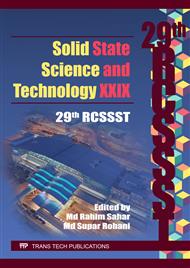p.365
p.370
p.374
p.379
p.387
p.393
p.401
p.407
p.413
A Comparative Analysis of Physical and Chemical Properties of Biochars and Bio-Oils Obtained from Pyrolytic Process of Mesocarp Fibre and Empty Fruit Bunch
Abstract:
The fundamental objectives of this study is to analyzed and compare the physical and chemical properties of pyrolysis products (biochar and bio-oil) derived from two oil palm wastes. Empty fruit bunch (EFB) and mesocarp fibre (MF) were subjected to pyrolysis at a temperature of 400 °C for 2 hours holding time at 10 °C/min heating rate and with nitrogen flow rate of 2 L/min. The result obtained from raw material showed that MF contains a high quantity of hemicellulose and lignin which led to a high yield of bio-oil and biochar respectively, whereby, EFB contained a high content of cellulose. The high content of cellulose in EFB resulted in a high yield of gas compared to fibre. The higher heating value (HHV) of biochar and bio-oil were found to be 28.76 and 19.45 MJkg-1 for MF and, 24.33 and 19.98 MJkg-1 for EFB, respectively. Comparatively, the biochar obtained from MF material has high HHV than EFB material. However, all the biochars derived can be used for briquettes production as coal replacement in the future due to significantly high calorific value as compared to Malaysian sub-bituminous coal which has 24.6 MJkg-1. Furthermore, pyrolysis of any wastes encourages proper sanitation and lead to a healthy environment. It can also serve as a potential solution to the energy crisis in developing countries, Nigeria in particular if bio-oil can be improved to power electricity generation facilities in replacement to diesel.
Info:
Periodical:
Pages:
387-392
Citation:
Online since:
October 2017
Keywords:
Price:
Сopyright:
© 2017 Trans Tech Publications Ltd. All Rights Reserved
Share:
Citation:


